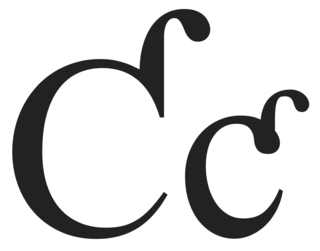 W
WȦ is a letter of the Latin alphabet, derived from A with the addition of a dot above the letter. It is occasionally used as a phonetic symbol for a low central vowel,. As a character in a computer file, it can be represented in the Unicode character encoding, but not the standard ASCII character encoding.
 W
WLatin alpha or script a is a letter of the Latin alphabet based on one lowercase form of a, or on the Greek lowercase alpha (α).
 W
WThe alveolar ridge is one of the two jaw ridges, extensions of the mandible or maxilla, either on the roof of the mouth between the upper teeth and the hard palate or on the bottom of the mouth behind the lower teeth. Most of the roof of one's mouth is the hard palate and the soft palate. The alveolar ridges contain the sockets of the teeth. They can be felt with the tongue in the area right above the top teeth or below the bottom teeth. Its surface is covered with little ridges.The [upper] alveolar ridge is a small protuberance just behind the upper front teeth that can easily be felt with the tongue.
 W
WAn apical consonant is a phone produced by obstructing the air passage with the tip of the tongue (apex) in conjunction with upper articulators from lips to postalveolar, and possibly prepalatal. It contrasts with laminal consonants, which are produced by creating an obstruction with the blade of the tongue, just behind the tip. Sometimes apical is used exclusively for an articulation that involves only the tip of the tongue and apicolaminal for an articulation that involves both the tip and the blade of the tongue. However, the distinction is not always made and the latter one may be called simply apical, especially when describing an apical dental articulation. As there is some laminal contact in the alveolar region, the apicolaminal dental consonants are also labelled as denti-alveolar.
 W
WƇ is a letter of the Latin alphabet, derived from C with the addition of a hook. It is used in African languages such as Serer.
 W
WḌ is a letter of the Latin alphabet, formed from D with the addition of a dot diacritic.
 W
WƊ is a letter of the Latin alphabet. The lower case, represents a voiced dental implosive or a voiced alveolar implosive in the International Phonetic Alphabet. It is used with the same value in the orthographies of various languages, notably some African languages, such as Fula and Hausa, also in Sindhi and used in Shona from 1931–1955.
 W
WHeng is a letter of the Latin alphabet, originating as a typographic ligature of h and ŋ. It is used for a voiceless y-like sound, such as in Dania transcription.
 W
W"How now brown cow" is a phrase used in elocution teaching to demonstrate rounded vowel sounds. Each "ow" sound in the phrase represents the diphthong /aʊ/. Although spelled "ow" in these four words, this same diphthong is also spelled "ou". Some examples of these homophonic /aʊ/s are the English words "house", "blouse", "noun", and "cloud". The use of the phrase "how now brown cow" in teaching elocution can be traced back to at least 1926.
 W
WInsular G is a form of the letter g somewhat resembling a tailed z, used in the medieval insular script of Great Britain and Ireland. It was first used in the Roman Empire in Roman cursive, then it appeared in Irish half uncial (insular) script, and after it had passed into Old English, it developed into the Middle English letter yogh. Middle English, having reborrowed the familiar Carolingian g from the Continent, began to use the two forms of g as separate letters.
 W
WJ̌ is a letter of the Latin alphabet, derived from J with the addition of a caron (háček). It is used in some phonetic transcription schemes, e.g. ISO 9, to represent the sound. It is also used in the Latin scripts or in the romanization of various Iranian and Pamir languages, Armenian, Georgian, Berber/Tuareg, and Classical Mongolian. The letter was invented by Lepsius in his Standard Alphabet on the model of š and ž to avoid the confusion caused by the ambiguous pronunciation of the letter j in European languages.
 W
WK with diagonal stroke is a letter of the Latin alphabet, derived from K with the addition of a diagonal bar through the leg.
 W
WK with stroke is a letter of the Latin alphabet, derived from K with the addition of a bar through the letter.
 W
WK with stroke and diagonal stroke is a letter of the Latin alphabet, derived from K with the addition of bars through the ascender and the leg.
 W
WLatin epsilon or open E is a letter of the extended Latin alphabet, based on the lowercase of the Greek letter epsilon (ε). It occurs in the orthographies of many Niger–Congo languages, such as Ewe, Akan, and Lingala, and is included in the African reference alphabet.
 W
WƝ is a letter indicating a palatal nasal. The lowercase form ɲ is used as an IPA symbol. The upper and lower case are used in the orthographies of some African languages.
 W
WNorvegia is a phonetic transcription system which was developed by Norwegian linguist Johan Storm in 1884. Norvegia is still employed in the teaching of Scandinavian studies at Norwegian universities.
 W
WThe Phonetics Laboratory is the phonetics laboratory at the University of Oxford, England. It is located at 41 Wellington Square, Oxford.
 W
WPraat is a free computer software package for speech analysis in phonetics. It was designed, and continues to be developed, by Paul Boersma and David Weenink of the University of Amsterdam. It can run on a wide range of operating systems, including various versions of Unix, Linux, Mac and Microsoft Windows. The program supports speech synthesis, including articulatory synthesis.
 W
WEsh is a character used in conjunction with the Latin script, which represents the voiceless postalveolar fricative.
 W
WTIPA is a free software package providing International Phonetic Alphabet and other phonetic character capabilities for TeX and LaTeX. Written by Rei Fukui , TIPA is based upon the author's previous work in TSIPA. In 2018, the TeX TIPA Roman font was selected as best representing the IPA symbol set by the International Phonetic Association's Alphabet, Charts and Fonts committee.
 W
WV with diagonal stroke is a letter of the Latin alphabet, derived from V with the addition of a bar through the left stroke.
 W
WThe letter V with hook is a letter of the Latin alphabet, based on an italic form of V, although it more closely resembles U. It is used in the orthographies of some African languages such as Ewe, and Shona from 1931 to 1955 to write. In Mossi (Mooré) it is used to write. In Kabiye and Ikposso it is used to write.
 W
WTurned v is a letter of the Latin alphabet, based on a turned form of V.
 W
WThe voiced retroflex trill is a sound that has been reported in Toda and confirmed with laboratory measurements. Peter Ladefoged transcribes it with the IPA symbol that is normally associated with the retroflex flap, ⟨ɽ⟩. Although the tongue starts out in a subapical retroflex position, trilling involves the tip of the tongue and causes it to move forward to the alveolar ridge. Thus, the retroflex trill gives a preceding vowel retroflex coloration, like other retroflex consonants, but the vibration itself is not much different from an alveolar trill. Thus, the narrower transcription ⟨ɽr⟩ is also appropriate.